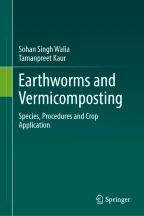Earthworms, Their Species, and Biological Features

Earthworms, a diverse group within the annelid class Oligochaeta, exhibit a rich tapestry of species and biological features that have fascinated researchers and ecological enthusiasts alike. This chapter provides an overview of earthworm diversity, highlighting their unique biological characteristics. Earthworms encompass a wide range of species, estimated at over 7000 globally. These species exhibit remarkable variation in size, coloration, and habitat preferences, adapting to environments as varied as tropical rainforests, arid deserts, and temperate soils. The biological features of earthworms contribute to their vital ecological roles. Their segmented bodies, featuring up to hundreds of segments, facilitate locomotion and burrowing. Earthworms display bilateral symmetry, with a distinct anterior end that houses sensory organs and a clitellum, which is a key reproductive structure. One of the most notable biological features of earthworms is their ability to regenerate segments, providing resilience against predators and environmental stresses. This regenerative capacity, along with their hermaphroditic reproductive system, where individuals possess both male and female reproductive organs, is a testament to their evolutionary adaptability.
This is a preview of subscription content, log in via an institution to check access.
Access this chapter
Subscribe and save
Springer+ Basic
€32.70 /Month
- Get 10 units per month
- Download Article/Chapter or eBook
- 1 Unit = 1 Article or 1 Chapter
- Cancel anytime
Buy Now
Price includes VAT (France)
eBook EUR 96.29 Price includes VAT (France)
Hardcover Book EUR 126.59 Price includes VAT (France)
Tax calculation will be finalised at checkout
Purchases are for personal use only
References
- Adhikary S (2012) Vermicompost, the story of organic gold: a review. Agric Sci 3(7):905–917 Google Scholar
- Arancon NQ, Edwards CA, Lee S (2002) Management of plant parasitic nematode population by use of vermicomposts. In: Proceedings of Brighton Crop Protection Conference-Pests and Diseases, Brighton, pp 705–716 Google Scholar
- Arancon NQ, Edwards CA, Yardim EN, Oliver TJ, Byrne RJ, Keeney G (2007) Suppression of two-spotted spider mite (Tetranychus urticae), mealy bug (Pseudococcus sp) and aphid (Myzus persicae) populations and damage by vermicomposts. Crop Prot 26:29–39 ArticleGoogle Scholar
- Arancon NQ, Edwards CA, Babenko A, Cannon J, Galvis P, Metzger JD (2008) Influences of vermicomposts, produced by earthworms and microorganisms from cattle manure, food waste and paper waste, on the germination, growth and flowering of petunias in the greenhouse. App Soil Ecol 39:91–99 ArticleGoogle Scholar
- Azarmi R, Giglou MT, Taleshmikail RD (2008) Influence of vermicompost on soil chemical and physical properties in tomato (Lycopersicum esculentum) field. Afr J Biotechnol 7(14):2397–2401 CASGoogle Scholar
- Canellas LP, Olivares FL, Okorokova AL, Facanha AR (2002) Humic acids isolated from earthworm compost enhance root elongation, lateral root emergence, and plasma H+-ATPase activity in maize roots. Plant Physiol 130:1951–1957 ArticleCASPubMedPubMed CentralGoogle Scholar
- Phillips HRP, Guerra CA, Bartz MLC, Briones MJI, Brown G, Crowther TW, Ferlian O, Gongalsky KB, van den Hoogen J, Krebs J, Orgiazzi A, Routh D, Schwarz B, Bach EM, Bennett J, Brose U, Decaëns T, König-Ries B, Loreau M, Mathieu J, Mulder C, van der Putten WH, Ramirez KS, Rillig MC, Russell D, Rutgers M, Thakur MP, de Vries FT, Wall DH, Wardle DA, Arai M, Ayuke FO, Baker GH, Beauséjour R, Bedano JC, Birkhofer K, Blanchart E, Blossey B, Bolger T, Bradley RL, Callaham MA, Capowiez Y, Caulfield ME, Choi A, Crotty FV, Dávalos A, DJD C, Dominguez A, Duhour AE, van Eekeren N, Emmerling C, Falco LB, Fernández R, Fonte SJ, Fragoso C, Franco ALC, Fugère M, Fusilero AT, Gholami S, Gundale MJ, López MG, Hackenberger DK, Hernández LM, Hishi T, Holdsworth AR, Holmstrup M, Hopfensperger KN, Lwanga EH, Huhta V, Hurisso TT, Iannone BV 3rd, Iordache M, Joschko M, Kaneko N, Kanianska R, Keith AM, Kelly CA, Kernecker ML, Klaminder J, Koné AW, Kooch Y, Kukkonen ST, Lalthanzara H, Lammel DR, Lebedev IM, Li Y, Lidon JBJ, Lincoln NK, Loss SR, Marichal R, Matula R, Moos JH, Moreno G, Morón-Ríos A, Muys B, Neirynck J, Norgrove L, Novo M, Nuutinen V, Nuzzo V, Rahman PM, Pansu J, Paudel S, Pérès G, Pérez-Camacho L, Piñeiro R, Ponge JF, Rashid MI, Rebollo S, Rodeiro-Iglesias J, Rodríguez MÁ, Roth AM, Rousseau GX, Rozen A, Sayad E, van Schaik L, Scharenbroch BC, Schirrmann M, Schmidt O, Schröder B, Seeber J, Shashkov MP, Singh J, Smith SM, Steinwandter M, Talavera JA, Trigo D, Tsukamoto J, de Valença AW, Vanek SJ, Virto I, Wackett AA, Warren MW, Wehr NH, Whalen JK, Wironen MB, Wolters V, Zenkova IV, Zhang W, Cameron EK, Eisenhauer N (2019) Global distribution of earthworm diversity. Science 366(6464):480–485. https://doi.org/10.1126/science.aax4851. Erratum in: Science. 2020 Jul 31;369(6503) ArticleCASPubMedPubMed CentralGoogle Scholar
Author information
Authors and Affiliations
- School of Organic Farming, Punjab Agricultural University, Ludhiana, Punjab, India Sohan Singh Walia & Tamanpreet Kaur
- Sohan Singh Walia

